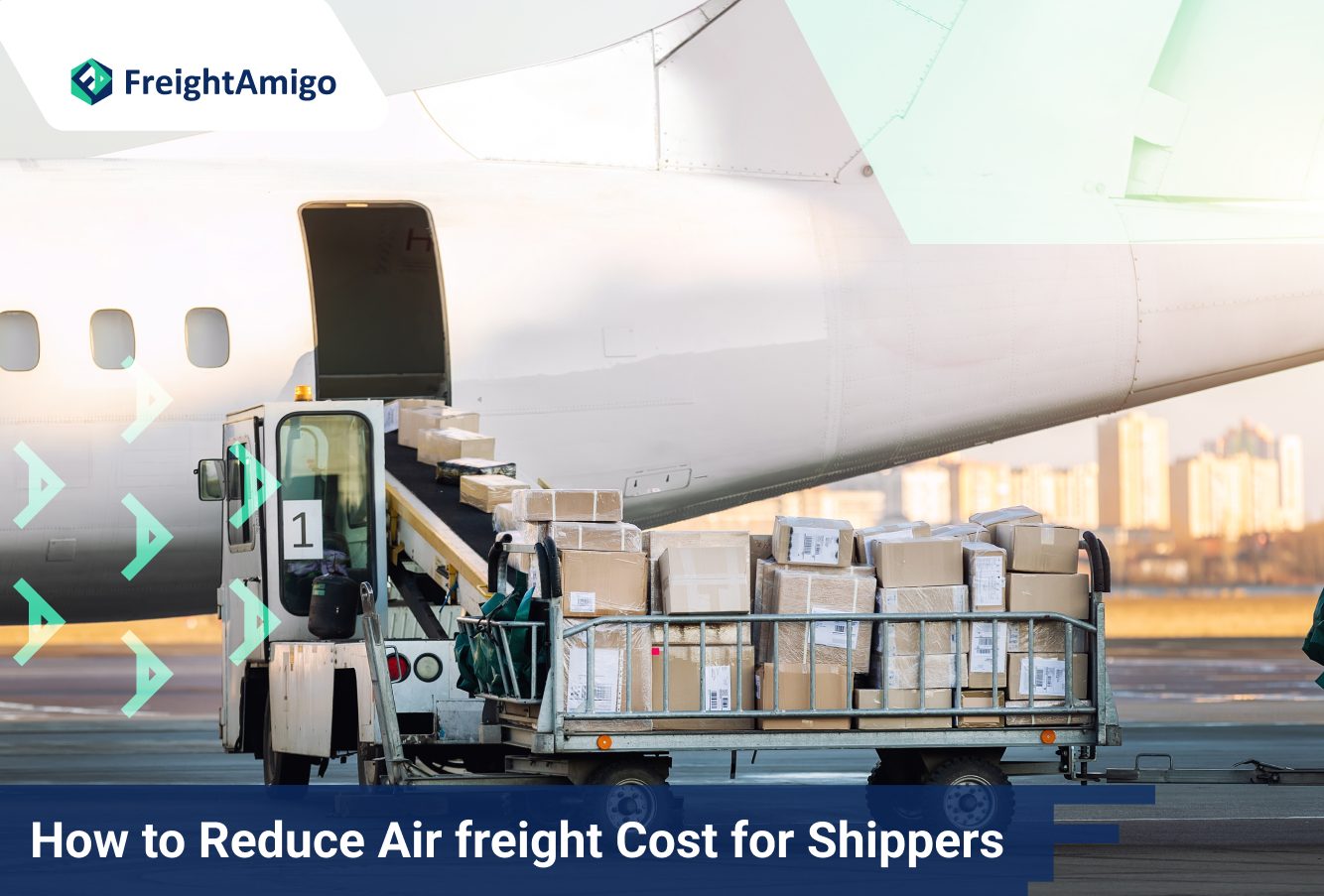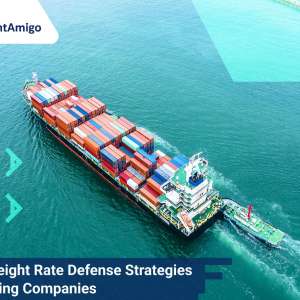8 Ways to Reduce Air freight Cost for Shippers
Latest update on 20 March, 2024 by Aurora Park– Marketing Analyst at FreightAmigo
Air freight is a popular but expensive mode of transportation for shippers. Air freight rates have been consistently increasing over the years due to rising fuel prices and operational expenses. As a result, air cargo shipments have become a significant cost factor for many companies. However, shippers can employ various strategies to reduce air freight costs and optimize their supply chain operations. FreightAmigo understands the challenges shippers face in managing air freight costs effectively. To provide valuable insights and solutions, FreightAmigo has written an informative article offering strategies to reduce air freight expenses and optimize supply chain operations.
Want To Compare The Best Express, Air Freight, Sea Freight, Rail Freight & Trucking Rates So As To Have Better Control On Cost?
Understanding Air Freight Cost Components
To effectively manage air freight costs, it is important to have a clear understanding of the key components that contribute to these costs:
- Fuel surcharge: Jet fuel prices cause this to fluctuate, and it can make up to 40% of the total freight rate.
- Base rate: The airline charges a basic rate to cover operational costs. Base rates vary depending on the route, volume, and season.
- Security fees: Airports charge fees for security screening and customs clearance.
- Pick-up and delivery costs: Trucking shipments to and from the airport incurs costs.
- Other surcharges: Additional fees, peak season surcharges, and currency adjustment factors.
Shippers can optimize their air freight spending by understanding the cost components. Thorough analysis of each element can identify potential areas for cost-saving measures and help devise strategies to mitigate expenses while ensuring service quality.
Optimizing Shipment Planning
Efficient shipment planning is crucial for shippers looking to reduce air freight costs. By carefully scheduling shipments, shippers can take advantage of consolidation opportunities, make the most of cargo space, and reduce the need for expedited or last-minute shipments. This approach allows businesses to benefit from economies of scale, negotiate better rates with carriers, and optimize route planning to minimize transit times and costs.
Consolidate Small Shipments
Consolidating small shipments into larger ones can reduce air freight costs for shippers. This is because combining smaller shipments into larger loads allows shippers to take advantage of economies of scale and receive volume discounts from airlines. Consolidation also improves cargo space utilization, reduces the number of individual shipments, and minimizes handling and administrative costs. Consolidating shipments helps shippers optimize routing and scheduling, reducing transit times.
Ship During Low Demand Periods
Air freight rates fluctuate based on market demand. Carriers often offer discounted rates during off-peak seasons to fill excess capacity and optimize flight schedules. Shipping during low demand periods minimizes the risk of capacity constraints and delays associated with peak shipping seasons. It also allows shippers to benefit from smoother operations, enhanced service reliability, and greater flexibility in securing preferred routes and flight options. Shippers can maximize cargo space efficiency and reduce shipping charges by aligning shipment schedules with low demand periods.
Compare Rates of Different Carriers
To minimize air freight costs, it is essential to compare rates from multiple carriers before booking shipments. By conducting thorough market research and obtaining quotes from various carriers, shippers can identify competitive pricing options and negotiate favorable terms. Shippers should analyze rate structures, such as base rates, fuel surcharges, and additional fees, to make informed decisions based on cost-effectiveness and service quality. Comparing carrier performance metrics, such as transit time, reliability, and customer service responsiveness, allows shippers to select carriers that meet their specific requirements and priorities. Technology solutions and freight rate management platforms can further streamline the rate comparison process and provide real-time visibility into pricing fluctuations and market trends.
Optimize Packing
Efficient cargo packing is crucial for optimizing space utilization and minimizing air freight costs. Shippers can achieve this by strategically using pallets and containers to maximize cargo density and minimize wasted space during transportation. This approach ensures compact packing, facilitates handling and loading processes, reduces the risk of damage, and improves overall operational efficiency. Shippers can optimize weight by removing unnecessary packaging or using alternative solutions that offer the same protection while minimizing bulk.
Route Optimization
Route optimization aims to balance transit time and cost efficiency. Shippers should research flight routes to identify options with the best transit time and lowest cost. Direct flights are faster but more expensive. Businesses must weigh the trade-offs between speed and cost to determine the most suitable route for their shipments. Shippers can use advanced route optimization software and analytic tools to conduct comprehensive analyses of various factors, such as flight options, durations, layover times, fuel surcharges, and carrier rates. This data-driven approach enables shippers to make informed decisions that accommodate their budget and align with delivery timelines.
Using Alternate Modes of Transport
Although air freight is the quickest mode of transportation, it is also the most expensive. When speed is not a priority, shippers can consider exploring more cost-effective alternatives, such as ocean freight or rail transport. These modes offer competitive pricing and can accommodate larger volumes of cargo, making them ideal choices for non-time-sensitive shipments. By strategically leveraging various transportation routes based on the specific requirements of each shipment, businesses can optimize their supply chain operations to achieve a balance between speed and cost-effectiveness.
Ocean Freight
Ocean freight is a cost-effective option for shipping goods with flexible delivery timelines. Although it takes longer, it can save a substantial amount of money, especially for non-urgent cargo. By aligning inventory planning with ocean freight schedules, businesses can optimize their supply chain expenses.
Rail Freight
Rail freight is a low-cost option for cargo with flexible delivery timelines. Transit times for rail freight are higher than air but lower than ocean. Using rail transport between inland container depots near the origin or destination makes it easier to connect efficiently to ocean freight and streamline port-to-port movements.
Intermodal Transport
Integrating multiple transportation modes, such as air, ocean, and rail, within a single shipment enhances flexibility and cost efficiency. Businesses can optimize transit times and minimize expenses by transferring cargo between modes at strategic hub terminals. This approach ensures swift delivery for time-sensitive segments of the journey, such as air transport, while capitalizing on cost savings for longer-haul transportation.
Leveraging Technology
Modern logistics technologies play a crucial role in reducing costs. They optimize air cargo operations through innovative solutions such as real-time tracking, automated cargo handling processes, and predictive analytics. These technologies help businesses streamline their operations and minimize costs.
Route Optimization Solution
The route optimization solution analyzes vast amounts of shipment data to recommend the most efficient air routes. This enables businesses to forecast air rates and identify the cheapest period for shipping to capitalize on cost-effective opportunities. Advanced algorithms consider factors such as distance, transit time, fuel consumption, and carrier preferences to determine the optimal route for each shipment. FreightAmigo offers route optimization algorithms by leveraging dynamic logistics data to help businesses streamline their air freight operations. This can be achieved by minimizing fuel consumption, reducing transit time, and maximizing cargo load efficiency. Route optimization solutions also provides real-time visibility into shipment statuses and locations, enabling businesses to proactively address potential delays and disruptions.
One-Stop Solution
Businesses should partner with experienced platform services to find the best balance between cost-effectiveness and transit time. Platform can leverage their expertise and extensive network to streamline supply chain operations and navigate the complexities of global trade with confidence. FreightAmigo connects with 1000+ logistics services providers and collaborates with businesses to pinpoint cost-saving opportunities while maintaining budget constraints, negotiating favorable rates and optimizing transit routes to ensure shipments reach their destination efficiently, thereby adding value at every step of the supply chain journey.
Conclusion
Air freight costs can make up a significant portion of logistics budgets for companies shipping high-value or urgent products. Companies can reduce air freight spending and optimize their overall supply chain operations by implementing strategies such as efficient shipment planning, optimizing packing, exploring alternate modes of transport, leveraging technology, and partnering with freight forwarders. Businesses can achieve a balance between speed and cost-effectiveness in air cargo logistics by combining these strategies.
For the optimal choice in air freight transportation, rely on the expertise of logistics professionals. If you’re planning to import abroad, visit FreightAmigo’s page for inquiries and assistance.
Read More:
The Advantages of Shared Truckload Shipping | FreightAmigo
Factors Impacting Freight Shipping Costs | FreightAmigo
Shipping Cost Data | Revolutionize Logistics Operations | FreightAmigo
If you have any inquiries on logistics/supply chain, feel free to contact FreightAmigo now:
Chat with us online | Hotline: +852 28121686 | WhatsApp: +852 27467829









































